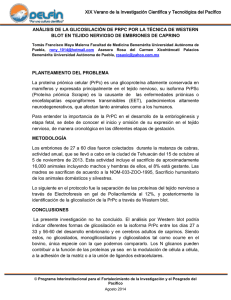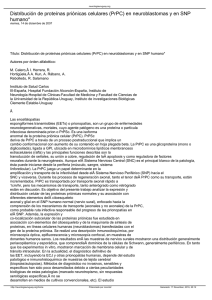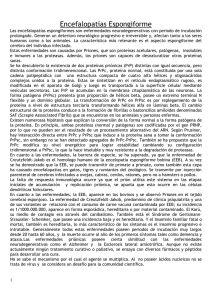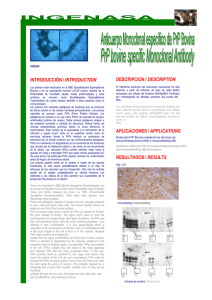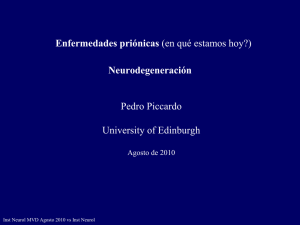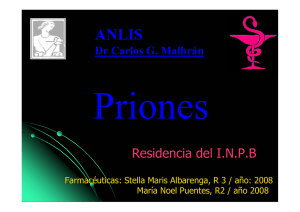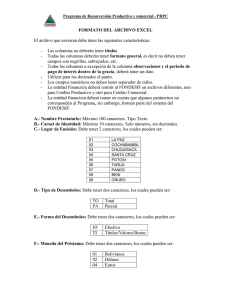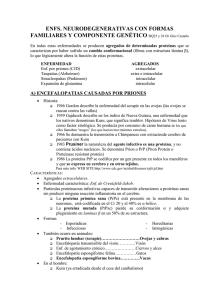El silenciamiento de la proteína priónica celular (PrP ) mediante
Anuncio
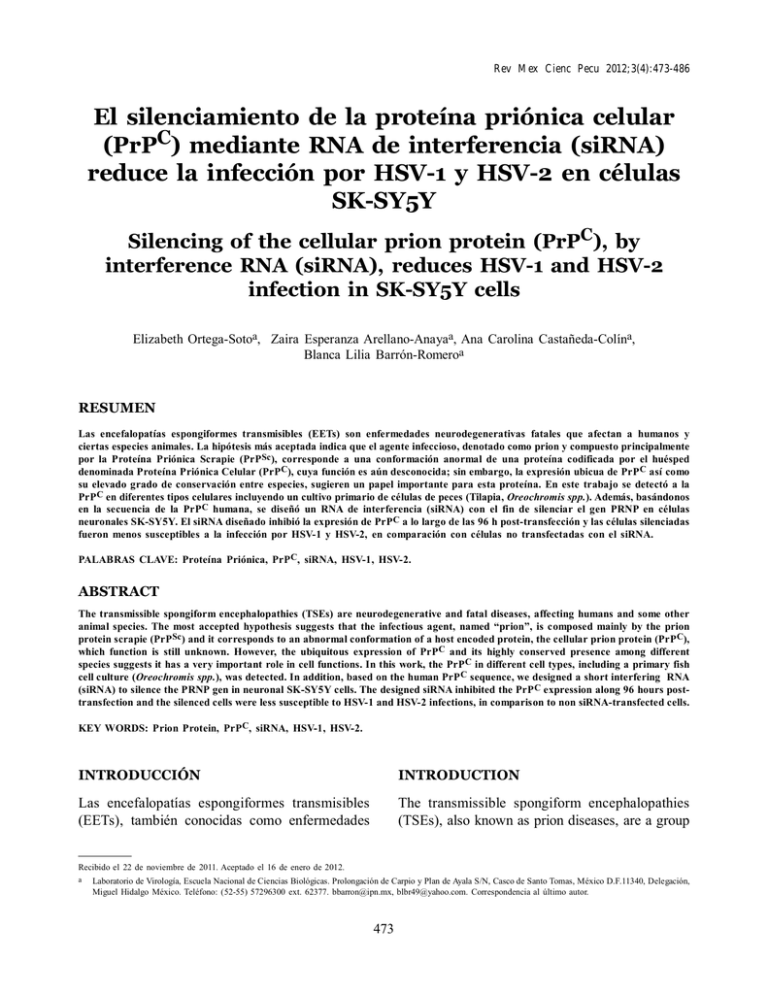
C EL SILANCIAMIENTO DE LA PROTEÍNA PRIÓNICA CELULAR Rev Mex (PrP Cienc ) Pecu 2012;3(4):473-486 El silenciamiento de la proteína priónica celular (PrPC) mediante RNA de interferencia (siRNA) reduce la infección por HSV-1 y HSV-2 en células SK-SY5Y Silencing of the cellular prion protein (PrPC), by interference RNA (siRNA), reduces HSV-1 and HSV-2 infection in SK-SY5Y cells Elizabeth Ortega-Sotoa, Zaira Esperanza Arellano-Anayaa, Ana Carolina Castañeda-Colína, Blanca Lilia Barrón-Romeroa RESUMEN Las encefalopatías espongiformes transmisibles (EETs) son enfermedades neurodegenerativas fatales que afectan a humanos y ciertas especies animales. La hipótesis más aceptada indica que el agente infeccioso, denotado como prion y compuesto principalmente por la Proteína Priónica Scrapie (PrPSc), corresponde a una conformación anormal de una proteína codificada por el huésped denominada Proteína Priónica Celular (PrPC), cuya función es aún desconocida; sin embargo, la expresión ubicua de PrP C así como su elevado grado de conservación entre especies, sugieren un papel importante para esta proteína. En este trabajo se detectó a la PrPC en diferentes tipos celulares incluyendo un cultivo primario de células de peces (Tilapia, Oreochromis spp.). Además, basándonos en la secuencia de la PrPC humana, se diseñó un RNA de interferencia (siRNA) con el fin de silenciar el gen PRNP en células neuronales SK-SY5Y. El siRNA diseñado inhibió la expresión de PrP C a lo largo de las 96 h post-transfección y las células silenciadas fueron menos susceptibles a la infección por HSV-1 y HSV-2, en comparación con células no transfectadas con el siRNA. PALABRAS CLAVE: Proteína Priónica, PrPC, siRNA, HSV-1, HSV-2. ABSTRACT The transmissible spongiform encephalopathies (TSEs) are neurodegenerative and fatal diseases, affecting humans and some other animal species. The most accepted hypothesis suggests that the infectious agent, named “prion”, is composed mainly by the prion protein scrapie (PrPSc) and it corresponds to an abnormal conformation of a host encoded protein, the cellular prion protein (PrPC), which function is still unknown. However, the ubiquitous expression of PrP C and its highly conserved presence among different species suggests it has a very important role in cell functions. In this work, the PrP C in different cell types, including a primary fish cell culture (Oreochromis spp.), was detected. In addition, based on the human PrP C sequence, we designed a short interfering RNA (siRNA) to silence the PRNP gen in neuronal SK-SY5Y cells. The designed siRNA inhibited the PrP C expression along 96 hours posttransfection and the silenced cells were less susceptible to HSV-1 and HSV-2 infections, in comparison to non siRNA-transfected cells. KEY WORDS: Prion Protein, PrPC, siRNA, HSV-1, HSV-2. INTRODUCCIÓN INTRODUCTION Las encefalopatías espongiformes transmisibles (EETs), también conocidas como enfermedades The transmissible spongiform encephalopathies (TSEs), also known as prion diseases, are a group Recibido el 22 de noviembre de 2011. Aceptado el 16 de enero de 2012. a Laboratorio de Virología, Escuela Nacional de Ciencias Biológicas. Prolongación de Carpio y Plan de Ayala S/N, Casco de Santo Tomas, México D.F.11340, Delegación, Miguel Hidalgo México. Teléfono: (52-55) 57296300 ext. 62377. [email protected], [email protected]. Correspondencia al último autor. 473 Elizabeth Ortega-Soto, et al. / Rev Mex Cienc Pecu 2012;3(4):473-486 priónicas, son un grupo de padecimientos que afectan tanto a animales como al ser humano, y se caracterizan por presentar un período de incubación de años y un amplio espectro de manifestaciones neurológicas, debido a la pérdida de neuronas del sistema nervioso central (SNC) por áreas, acompañada de una activación de astrocitos, sin infiltrado inflamatorio y generalmente con depósitos de placas amiloides (material proteínico con un alto contenido de tiras b-plegadas)(1,2).Estas enfermedades incluyen al Kuru, la enfermedad de Creutzfeldt-Jakob (CJD), el síndrome de Gerstmann-Sträussler-Scheinker (GSS) y el Insomnio Familiar Fatal (IFF) en seres humanos, así como el Scrapie en ovejas y cabras, la encefalopatía esponjiforme bovina (EEB), y encefalopatías en visones, felinos, venados y alces(3-5). Todas ellas se relacionan con la presencia de una forma anormal de la Proteína Priónica Celular (PrPC), denominada como Proteína Priónica Scrapie (PrPSc), la cual se considera el agente causal de las EETs. of neurological disorders that affect animals and humans. They are characterized by long incubation periods (years) and wide range of neurological manifestations, mainly due to the loss of central nervous system (CNS) neurons, accompanied by activation of astrocytes, without inflammatory infiltration and generally with amyloid deposits (beta-sheet rich protein material) (1,2) . These diseases include Kuru, Creutzfeldt-Jacob disease (CJD), Gerstmann-Sträussler-Scheinker (GSS) and fatal familial insomnia (IFF) in humans, as well as scrapie in sheep and goats, bovine spongiform encephalopathy (BSE), and encelopathies in minks, felines, deer and elks(3-5). All of them are associated with the presence of an abnormal form of cellular prion protein (PrPC), called prion protein scrapie (PrPSc), which is considered the causative agent of TSE. The PrPC is a highly conserved protein among different mammalian, bird and fish species; however, its function has not been clarified. Mice in which PrP C has been eliminated can suffer alterations in the hippocampal function, spatial learning, copper metabolism, phagocytosis and inflammatory response. The PrPC is expressed in neurons and other cells of the CNS, but it has also been detected in immune system cells, among others(6). The presence of PrPC in different types of cells makes possible its transmission, since the PrPSc is capable to amplify itself by transferring its biochemical properties to the PrPC. La PrPC se encuentra altamente conservada entre diferentes especies de mamíferos, aves y peces; sin embargo su función aún no se ha dilucidado. Ratones a los que se les ha eliminado la PrPC pueden sufrir alteraciones en la función hipocampal, el aprendizaje espacial, el metabolismo de cobre, fagocitosis y la respuesta inflamatoria. La PrPC se expresa en neuronas y otras células del SNC, pero también se ha detectado en células del sistema inmune, entre otras(6). La presencia de PrPC en diferentes tipos de células hace posible su transmisión, ya que se considera que la PrPSc es capaz de amplificarse trasfiriendo sus características bioquímicas a la PrPC. With the aim to elucidate PrPC function, interfering RNAs (siRNA) have been used to block the specific expression of this protein by interacting and inducing the degradation of the correspondent mRNA, due to the activation of the slicer enzyme. In goats, PrPC expression has been decreased by using siRNA(7). Mice treated with siRNA showed a decrease of PrPC expression and an increase in survival after being inoculated with RML prion strain(8). In cell cultures such as N2a and GT-1, the PRNP gene has been silenced, thus preventing PrPSc formation(8). Using siRNA complementary to codons 392 to 410 of murine PrPC, N2aS12sc+ Con el fin de elucidar la función de la PrPC, se han utilizado RNAs de interferencia (siRNA), para bloquear la expresión específica de dicha proteína, al interaccionar e inducir la degradación del correspondiente mRNA, mediante la activación de la enzima Slicer. En cabras se ha demostrado la reducción de la expresión de PrPC(7) mediante siRNA. Ratones tratados con siRNA mostraron un incremento en la supervivencia después de ser 474 EL SILANCIAMIENTO DE LA PROTEÍNA PRIÓNICA CELULAR (PrPC) inoculados con la cepa priónica RML debido a la disminución de la expresión de PrPC(8). En cultivos celulares como N2a y GT-1 se ha logrado silenciar el gen PRNP previniendo así la formación de PrPSc(8). Usando un siRNA complementario a los codones 392 al 410 de la PrPC murina se han curado células N2aS12sc+ infectadas persistentemente con priones(9). Los siRNAs son eficaces contra todas las cepas de PrPSc(10), sin embargo, se carece de un mecanismo que inserte estas moléculas en la célula blanco. Recientemente se ha propuesto el uso de péptidos acarreadores, capaces de reconocer receptores de acetilcolina, y llevan adheridos siRNAs dirigidos contra las secuencias 1578, 1633 y 1672 (a partir del sitio de inicio de la trascripción de la PrPC murina), con los que se ha logrado reducir la expresión de PrPC, así como la formación de PrPSc en cultivos celulares infectados(11). Por otro lado, se ha observado que ratones que expresan niveles altos de PrPC incrementan su susceptibilidad a la infección con el virus herpes simplex tipo 1 (HSV-1) y la carencia de la expresión de PrPC favorece el establecimiento de la latencia de HSV(12). (persistently prion-infected) cells have been cured(9). The siRNAs are efficient against all PrPSc strains(10); however, a mechanism that inserts these molecules in the target cell is lacking. One approach to solve this problem has been the use of carrier peptides, capable to recognize acetylcholine receptors, containing siRNAs directed against several sequences (1578, 1633 and 1672 from the transcriptional initial site) of the murine PrPC, to successfully decreased the expression of PrPC, as well as PrPSc formation in infected cell cultures(11). Conversely, it has been observed that mice expressing high levels of PrP C increase their susceptibility to herpes simplex virus type 1 (HSV-1) infection and the lack of PrPC expression, favors the establishment of HSV latency(12). The aim of this study was to look for the PrPC in different types of cells as well as to design a siRNA based on human PrPC sequence to silence the PrPC in human neuroblastom cells (SK-SY5Y). The PrPC silenced cells showed a decreased susceptibility to infections caused by HSV-1 and HSV-2, which suggests that the alteration of PrPC expression could also modulate some viral infections. En este trabajo se propuso la búsqueda de PrPC en diferentes sustratos celulares, así como el diseño de un siRNA basado en la secuencia de la PrPC humana, el cual fue capaz de silenciar a la PrPC en células de neuroblastoma humano (SK-SY5Y). Dichas células mostraron una susceptibilidad reducida contra infecciones producidas por HSV-1 y HSV-2, lo que sugiere que la alteración de la expresión PrPC también podría modular algunas infecciones virales. MATERIALS AND METHODS Detection of cellular prion protein by immunohistochemistry (IHC) and Western blot In order to detect PrPC by immunohistochemistry (IHC), different cells such as NIE-115 (mouse neuroblastoma), SK-SY5Y (human neuroblastoma)), human monocyte-macrophage cell line GCT, U-937, J-774 and P-338, and Vero cell line, originated from monkey kidney, were grown in glass coverslips until 60 % of confluence was reached, then cells were fixed on the coverslips with methanol-acetone 1:1 for 15 min. Thereafter, coverslips were washed with TBS and blocked with fixation reagent (Bio-Rad®). Cells were incubated with the monoclonal antibody (mAb) 6H4 all night long at 4 °C; the mAb not bound to the cells was washed twice with TBS. Then, the biotinylated secondary antibody (BioRad®) was added for one hour and proceeded to incubate with the soluble complex of biotinylated MATERIALES Y MÉTODOS Detección de la proteína priónica celular mediante inmunohistoquímica (IHC) y Western Blot Para llevar a cabo la detección de la PrPC por inmunohistoquímica (IHC), diferentes células como NIE-115 (neuroblastoma de ratón), SK-SY5Y (neuroblastoma humano), células de tipo monocitomacrófago humanas GCT, U-937, J-774 y P-338 y la línea celular Vero, proveniente de riñón de mono, 475 Elizabeth Ortega-Soto, et al. / Rev Mex Cienc Pecu 2012;3(4):473-486 se crecieron en cubreobjetos hasta alcanzar un 60 % de confluencia, y se fijaron a la superficie con metanol-acetona 1:1 por 15 min. Posteriormente, los cubreobjetos se lavaron con TBS y se bloquearon con un reactivo fijador (BioRad ®). Las células se incubaron con el anticuerpo monoclonal (mAb) 6H4 durante toda la noche a 4 °C, el mAb no unido a las células se lavó dos veces con TBS. A continuación se adicionó el anticuerpo secundario biotinilado (BioRad ®) por una hora y se procedió a incubar con el complejo soluble de estreptavidina-peroxidasa biotinilada, el cual se une a la biotina del anticuerpo secundario, seguido por un periodo de incubación de 10 min con biotiniltiramida. Con el fin de amplificar la reacción, las células se incubaron nuevamente con el complejo estreptavidina-peroxidasa biotinilada por una hora, el exceso se lavó con PBS. Para poner en evidencia la reacción, se utilizó una solución reveladora del ABC Kit (Vectastain ®) y se lavaron con agua destilada para detener la reacción. Las preparaciones obtenidas se montaron sobre portaobjetos usando resina sintética y se observaron al microscopio de luz visible. streptavidine-peroxidase, which binds to the biotin of the secondary antibody, followed by 10 min incubation with biotinyl-tyramide, to amplify the reaction. Cells were incubated again with the biotinylated streptavidine-peroxidase complex for one hour; the excess was removed by washing it with PBS. In order for the reaction to take place, a developer solution from ABC Kit (Vectastain®) was used and was washed with distilled water to stop the reaction. The preparations obtained were mounted on glass slides using synthetic resin and observed through the light microscope. Western blot was performed using cell homogenates from confluent cell cultures. Cells were resuspended in water and then centrifuged. Proteins from the cell homogenates were separated by electrophoresis in a 10% polyacrylamide gel (under denaturing conditions), and the, transferred to a nitrocellulose membrane to be blocked with 5% skimmed milk. The immunological detection was carried out by incubating with the mAb 6H4 (Prionics®) or the mAb 3F4 (SIGNET®), the nonbound antibody was washed with PBS. Thereafter, the strips were incubated with the secondary antibody (alkaline phosphatase alkaline conjugate), eliminating the excess with PBS washes. Finally, the antibody-antigen reaction was evidenced adding BCIP/NBT substrate. El Western blot se realizó con homogeneizados celulares a partir de cultivos celulares confluentes. Las células se resupendieron en agua y posteriormente se centrifugaron. Las proteínas de los homogeneizados celulares se separaron por electroforesis en un gel de poliacrilamida al 10% (bajo condiciones desnaturalizantes) y se transfirieron a una membrana de nitrocelulosa y se bloquearon con leche descremada al 5%. La detección inmunológica se llevó a cabo incubando con el mAb 6H4 (Prionics®) o el mAb 3F4 (SIGNET®), el anticuerpo no unido se lavó con PBS. A continuación las tiras se sometieron a incubación con el anticuerpo secundario (conjugado con fosfatasa alcalina), eliminando el exceso con lavados con PBS. Finalmente la reacción antígeno anticuerpo se evidenció adicionando BCIP/NBT. PrPc silencing A siRNA was designed, based on the human PrPc sequence (access number AY569456, using the BLOCKit TM RNAiDesigner (Invitrogen®), siRNA Desing Tool (QIAGEN®), siRNA Target finder (AMBION®) and SiRNAdesigner (Bioinformatics and Research Computing, Whitehead Institute) tools. The sequences that appeared more frequently in all programs used were selected; of these, the ones that fulfilled the criteria of Reynolds were chosen(13). The siRNA was synthesized in Invitrogen®, obtaining forward and reverse strands (chains) with two extra nucleotides at its 3’ end. In order to silence the PrPc protein, SK-SY5Y cells were propagated in Dulbecco’s modified Eagle’s medium, supplemented with 10% Silenciamiento de PrPC Se diseñó un siRNA, basado en la secuencia de la PrPC humana (clave de acceso AY569456), con 476 EL SILANCIAMIENTO DE LA PROTEÍNA PRIÓNICA CELULAR (PrPC) ayuda de los programas BLOCKit TM RNAiDesigner (Invitrogen®), siRNA Desing Tool (QIAGEN®), siRNA Target finder (AMBION®), SiRNAdesigner (Bioinformatics and Research Computing, Whitehead Institute). Se eligieron las secuencias que aparecieron con mayor frecuencia en todos los programas usados; de ellas se seleccionaron las que cumplieran con los criterios de Reynolds (13) . El siRNA se sintetizó en Invitrogen® obteniendo la cadena sentido y antisentido con dos nucleótidos extra en los extremos 3’. Para llevar a cabo el silenciamiento, las células SK-SY5Y fueron propagadas en medio Eagle modificado de Dulbecco suplementado con 10% de suero fetal bovino y se transfectaron con el siRNA usando el RNAiStarter Kit de acuerdo con las instrucciones del fabricante (Invitrogen ®). Brevemente, 8X104 células se sembraron en cada pozo de una microplaca de cuatro pozos (1.9 cm2 de superficie por pozo); una vez alcanzada una confluencia entre 50 y 80 %, las células se transfectaron con 1 mg de siRNA en 100 µl de regulador EC-R al que se agregaron 6 µl de RNAiFect. A las células se les adicionaron 300 µl de medio de cultivo y la mezcla siRNA-RNAiFect. Las células se incubaron y a diferentes tiempos de post-transfección se procedió a verificar el silenciamiento de PrPC mediante la detección de la proteína por Western Blot, como se describió anteriormente. Como control negativo se utilizó un siRNA que no tiene complementariedad conocida contra genes de mamíferos (RNAiStarter Kit). Como testigo positivo de silenciamiento, se empleó el siRNA contra lamin A/C y el silenciamiento de la lamin A/C se corroboró mediante Western blot empleando un anticuerpo anti lamin A/C (Donado por el Dr. Carlos Arias, IBT UNAM) el cual se evidenció con un anticuerpo anti ratón conjugado a fluoresceína. Infección con HSV-1 y 2 en silenciadas bovine foetal serum and the, transfected with the siRNA using the RNAiStarter Kit, according to the manufacturer’s instructions (Invitrogen®). Briefly, 8 × 104 cells were seeded in each well of a four well microplate (1.9 cm2 of surface per well); once the confluence was reached between 50 and 80 %, cells were transfected with 1 µg of siRNA in 100 µl of EC-R buffer in which 6µl of RNAiFect were added. Cells were re-fed with 300 µl of cell culture medium, and incubated. At different times posttransfection, PrPc silencing was detected by Western blot protein detection assay, as described before. As negative control, a siRNA, which does not have any known complementarity against genes in mammals (RNAiStarter Kit) was used. As positive silencing control, the siRNA against lamin A/C was used, and the silencing of lamin A/C was corroborated by Western blot, using anti-lamin A/C antibody (Donated by Dr. Carlos Arias, IBT UNAM), which was evidenced by an anti-mouse fluorescein conjugate. Infection with HSV-1 and 2 in silenced cells 8 × 104 silenced cells/per well were grown in four well microplates and were incubated for 24 h; afterwards, they were infected with HSV-1 or HSV-2 at one MOI and incubated at 37 ºC until cytopathic effect was observed. The virus was harvested by freezing and thawing the cells and the supernatant was collected after centrifugation. The viral titer was determined by the TCID50 method and calculated by the Spearman-Kärber formula. As control, cells without siRNA transfection were infected with HSV-1 or HSV-2. RESULTS PrPC detection in cell cultures With the aim to standardize PrPC detection by Western blot in cell cultures, the presence of PrPC in several cells such as: NIE-115 and SK-SY5Y (neuronal cell lines), GCT, U-937, J-774 and P338 (monocyte-macrophage cell lines), and Vero (monkey kidney cell line) was analyzed. The PrPC protein was present in all the cell types used. las células 8X104 células silenciadas se crecieron en microplacas de cuatro pozos y se incubaron por 24 h, posteriormente se infectaron con HSV-1 o HSV-2 477 Elizabeth Ortega-Soto, et al. / Rev Mex Cienc Pecu 2012;3(4):473-486 a una MOI de 1 y se incubaron a 37 °C hasta observar efecto citopático. El virus se cosechó por congelamiento y descongelamiento de las células separando el sobrenadante por centrifugación. El virus obtenido se tituló por el método de TCID50 y se calculó mediante la fórmula de SpearmanKärber. Como testigo se utilizaron células sin transfectar con el siRNA, las cuales fueron infectadas con HSV-1 y HSV-2. Figure 1A shows, as an example of PrPC detection in NIE-115 and Vero cells by IHC. Figure 1B shows the detection of PrPC by using Western blot in cell extracts obtained from Vero and SK-SY5Y cells. The PrPC was also detected in primary cell culture of Tilapia (Figure 1C), which demonstrated that PrPC is expressed in several types of cells, and suggests that this protein is conserved among different animal species, including fishes. RESULTADOS Design of siRNA against PrPC Detección de PrPC en cultivos celulares Since PrPC is widely distributed among several species and also among different types of cells, a siRNA directed against the human PrP C was designed, to silence its gene. Five sequences found Con el fin de estandarizar la detección de PrPC en cultivos celulares, se analizó la presencia de PrPC por Western blot en líneas celulares de tipo neuronal NIE-115 y SK-SY5Y, en células de tipo monocitomacrófago GCT, U-937, J-774 y P-338 y en la línea celular Vero. La proteína de PrPC se encontró presente en todos los tipos de células utilizadas y en la Figura 1A se muestra, como ejemplo, la detección de PrP C en células NIE-115 y Vero mediante IHC. En la Figura 1B se observa la detección de PrPC mediante el uso de Western blot en extractos obtenidos a partir de células Vero y SK-SY5Y. La PrPC también fue detectada en un cultivo primario de Tilapia (Figura 1C), lo que demuestra que la PrPC se expresa en muy diversos tipos celulares, y sugiere que esta proteína se encuentra conservada entre diversas especies animales incluidas los peces. Figura 1. Detección de PrPC en diferentes sustratos celulares Figure 1. PrPC detection in different cell types 40X 40X NIE-115 A) 64 kDa Diseño del siRNA contra PrPC Ya que la PrP C se encuentra ampliamente distribuida entre diversas especies y además entre los diferentes tipos celulares probados, se diseñó un siRNA dirigido contra la PrPC humana con el fin de silenciar su gen. Cinco secuencias encontradas mediante el uso de diferentes programas para generar siRNAs fueron seleccionadas y analizadas bajo los criterios de Reynolds(13). El siRNA correspondiente a los nucleótidos del 297 al 319 del mRNA de la PrPC humana mostró siete de los ocho criterios propuestos para un siRNA. La secuencia B) 1 2 Vero 3 64 kDa 48 kDa 48 kDa 32 kDa 32 kDa 16 KDa 16 KDa 1 2 3 4 C) A) Detection of PrPC in NIE-115 and Vero cells by IHC. Reactivity on the cellular surface of both cell types is observed. B) Western blot detection of PrPC in Vero and SK-SY5Y cells, showing the presence of three bands of approximately 33, 35 and 37 kDA that correspond to PrPC. Lane 1, an extract of SK-SY5Y cells; lane 2, Vero cells extract. As negative control, SK-SY5Y cells in the absence of mAB 6H4 were placed in lane 3. C) PrPC detection in a primary culture of Tilapia. The presence of two bands of approximately 34 and 35 kDa from Tilapia were observed on Western blot (lines 1 and 2). As negative control, cellular extracts of the Tilapia culture were subjected to the same procedure but in the absence of mAb 6H4. 478 EL SILANCIAMIENTO DE LA PROTEÍNA PRIÓNICA CELULAR (PrPC) correspondiente a dicho siRNA es S5’: ACAAG CCGAGUAAGCCAAA dTdT, cuya secuencia antisentido es: 3’ TdTd UGUUCGGCUCAU UCGGUUU. Con el fin de verificar que el siRNA diseñado era capaz de unirse al mRNA de PrPC se analizó la estructura probable del mRNA de PrPC con ayuda de los programas RNA structure(14) y RNA fold(15). Se generaron diversas estructuras, pero sólo se seleccionó una estructura subóptima, que es la que tiene mayor estabilidad, y en ella se marca el sitio blanco de unión del siRNA. En esa región se ven claramente zonas no apareadas (“loop”) de manera que al inicio, en medio y al final se ese sitio se pueden unir el siRNA (Figura 2A y B). Para verificar que el siRNA diseñado era específico para PrPC humana, se llevó a cabo un blast que arrojó como resultado homología de dicha secuencia para la PrPC humana con valores de identidad del 100% (Valor E 0.040). El siRNA comparte un 68 % de su secuencia con el gen de la ribonucleoproteína nucleolar pequeña U3 (Valor E de 150) lo que hace poco probable su unión a mRNAs correspondientes a otras proteínas. También se realizó la búsqueda en la base de datos de virus, obteniendo como secuencia similar al virus del mosaico del calabacín (identidad 73 %, valor E 13) y el virus de la fiebre aftosa (identidad 73 %, valor E 13), sin que ninguno de los dos datos sea significativo para señalar una posible interacción entre el siRNA diseñado y dichos virus, eliminando así la posibilidad de interacción entre el siRNA y los virus herpes. by the use of different programs to generate siRNAs, were selected and analyzed under Reynolds criteria(13). The siRNA correspondent to nucleotides from 297 to 319 of mRNA of human PrPC, fulfilled seven out of eight criteria proposed for siRNA. The correspondent sequence to such siRNA is S5’: ACAAGCCGAGUAAGCCAAA dTdT, whose reverse sequence is: 3’ TdTd UGUUCGGCUCAUUCGGUUU. To verify if the designed siRNA was capable to bind to PrP C mRNA, the probable structure of PrPC mRNA was obtained with RNA structure (14) and RNA fold(15) programs. Several structures were generated, but only a suboptimal structure was chosen, which is the one with higher stability and the siRNA-binding site is depicted. In this region, no pared regions are observed (loops), so at the start, middle and end of that site siRNA can be bound (Figure 2A and B). To verify if the designed siRNA was specific to human PrPC, a BLAST analysis was carried out, displaying sequence homology with human PrPC, with identity values of 100 % (E value of 0.040). The siRNA shared 68 % of its sequence with the Figura 2. Estructura del mRNA de PrPC y su interacción con el siRNA Figure 2. Structure of PrPC mRNA and its interaction with the designed siRNA Silenciamiento de PrPC mediante el siRNA Una vez sintetizado el siRNA se procedió a transfectar las células SK-SY5Y. El siRNA silenció el gen de la PrP C en las células transfectadas mientras que las células sin siRNA expresaron la PrPC de manera normal. El testigo positivo de silenciamiento, siRNA contra lamin A/C fue capaz de silenciar a su proteína blanco, por lo que el anticuerpo anti lamin A/C no se pudo unir a las células transfectadas (datos no mostrados). La expresión de PrPC al ser analizada a diferentes tiempos post-transfección por Western blot usando A B Prediction of PrPC mRNA secondary structure generated by the RNAstructure 4.1 programme. The box shows the binding target site of 217-319 siRNA. B) An amplification of the box showing the site of mRNA interaction with the designed siRNA, the upper arrow shows the initial site of interaction in the loop of the chain on the left side and the lower arrow the terminal site of interaction. 479 Elizabeth Ortega-Soto, et al. / Rev Mex Cienc Pecu 2012;3(4):473-486 el mAb 3F4 mostró la inhibición de la expresión de la PrP C desde las 24 hasta las 96 h posttransfección (Figura 3). gene of U3 small nucleolar ribonucleoprotein (E value of 150), which makes unlikely its binding to others mRNAs. Also, a virus database search was performed, obtaining similarity with the zucchini yellow mosaic virus (73 % identity, E value of 13) and the foot-and-mouth disease virus (73 % identity, E value of 13), and none the two data has a significant value to indicate a possible interaction between the designed siRNA and such viruses, thus eliminating the possibility of interaction between the siRNA and herpes virus. De acuerdo con reportes previos, ratones que carecen de PrPC no son permisivos para la infección con HSV-1, mientras que aquellos animales que sobre expresan PrP C muestran una infección exacerbada(12). Con la finalidad de investigar si la ausencia de la proteína PrPC afectaba de manera directa la capacidad de infección de los virus HSV-1 y HSV-2 a células neuronales, las células SK-SY5Y transfectadas con el siRNA fueron infectadas con HSV-1 (cepa MacIntyre) o HSV-2 (cepa G) a las 24 h post transfección como se describe en la sección de materiales y métodos. Como resultado del silenciamiento, se observó que las células transfectadas con el siRNA fueron menos susceptibles a la infección viral, mostrando una reducción en el efecto citopático característico para ambos virus, más aún, el título del virus obtenido después de la infección también se vio reducido de106.4 /ml a 105.7 /ml (49 % reducción) para HSV-1 y 105.6/ml a 104.6/ml (67 % reducción) para HSV-2 (P<0.05). PrPc silencing by siRNA Once siRNA was synthesized, SK-SY5Y cells were transfected. The siRNA silenced PrP C gene in transfected cells, while cells without siRNA expressed PrPC in a normal way. The silencing positive control, siRNA against lamin A/C was capable to silence its target protein, and therefore, the anti-lamin A/C antibody was not able to bind to transfected cells (data not shown). PrPC expression, analyzed at different times after transfection by Western blotting, using the mAb 3F4, showed inhibition of PrPC from 24 to 96 h post-transfection (Figure 3). DISCUSIÓN Figura 3. Silenciamiento de PrPC en células SK-SY5Y La PrPC se encuentra altamente conservada entre mamíferos, y es expresada en diferentes tipos celulares, sin embargo su función no se ha dilucidado. En el presente trabajo se diseñó un siRNA contra la PrPC humana que puede ser útil para el estudio de la función de dicha proteína, así como una posible terapia contra estas enfermedades en diferentes especies animales. Figure 3. PrPC silencing in SK-SY5Y cells siRNA - 24 hrs 48 hrs 72 hrs 96 hrs - - - - + + + + 97.4 66.3 55.4 En primer lugar analizamos la presencia de PrPC en cultivos celulares con el fin de estandarizar su detección en diversas células. La PrPC se detectó en cultivos celulares de tipo monocito-macrófago mediante IHC y Western Blot. En trabajos previos, la PrPSc se ha encontrado asociada con linfocitos B pero no con monocitos; sin embargo la PrPC se ha detectado en plaquetas, células NK, linfocitos T CD8+ y CD4+, linfocitos B y granulocitos en 36.5 21.5 W estern blot showing the absence of PrP C at 24, 48, 72 and 96 h after transfection with PrPC siRNA (siRNA+); in contrast with the presence of a protein band of approximately 36 kDa observed in non-transfected cells (siRNA-). The first lane corresponds to non-transfected cellular extracts without mAb 3F4 (anti PrPC). 480 EL SILANCIAMIENTO DE LA PROTEÍNA PRIÓNICA CELULAR (PrPC) sangre(16). En virtud de que todas las células analizadas (NIE-115, SK-SY5Y, GCT, U-977, P-338 y Vero) presentaron la proteína PrPC, se propuso la búsqueda de la PrPC en cultivos primarios de células de epidermis de Tilapia (Oreochromis spp.), considerando que su presencia puede ser un indicativo de la posibilidad de la adquisición de la enfermedad, encontrando la expresión de PrPC en dichas células, lo que correlaciona con reportes previos donde se detectó la presencia de un mRNA para PrPC en el pez fugu japonés (Takifugu rubripes)(17). Además, en apoyo a nuestro hallazgo, se ha sugerido que la proteína de peces posee una estructura 3D similar a la PrPC de mamíferos, se encuentra glicosilada y posee glicofosfadil inositol (GPI) como molécula de anclaje(18). La PrPC de Tilapia fue reconocida mediante el mAb 6H4. Previamente se reportó que los anticuerpos 6H4 y 12F10 no reconocieron a la PrPC del pez conocido como la dorada (Sparus aurata), así como la PrPC de mamíferos no es reconocida por anticuerpos policlonales dirigidos contra la PrPC de peces(19). Sin embargo, se sabe que el anticuerpo 6H4 reconoce el péptido DYEDRYYRE (20) , el cual está presente en humanos, bovinos, ovejas, conejos, mink y primates. Dicha secuencia se encuentra en la proteína priónica humana entre los aminoácidos 144-152. Aunque en ratón, hámster y rata la tirosina de la posición 145 está reemplazada por un triptófano, este cambio no impide que la proteína PrP reaccione con el mAb 6H4 (Prionics®). Por lo que podemos suponer que este epítopo, que está altamente conservado en diferentes especies de mamíferos (21) , pudiera encontrarse también en la PrPC de Tilapia, cuya secuencia aún no se ha publicado. La presencia de PrPC en peces tiene suma importancia, ya que posibilita la transmisión de PrP Sc entre ellos, especialmente si consideramos la existencia de canibalismo entre peces. Experimentalmente, en espáridos infectados con BSE y scrapie no se observaron signos de enfermedad, sin embargo se observó la acumulación de PrPSc(19), sugiriendo la posibilidad de una diseminación del agente infeccioso, lo cual pudiera representar incluso un riesgo para la salud humana, aunque a la fecha esto no se ha demostrado. According to previous reports, mice lacking PrPC are not permissive for HSV-1 infection, while those animals that overexpress PrPC show and exacerbate the infection(12). To investigate if the absence of PrPC protein directly affected the capacity of neuronal cells to be infected by of HSV-1 or HSV-2 viruses, the SK-SY5Y transfected cells with siRNA were infected with HSV-1 (Maclntyre strain) or HSV-2 (G strain) at 24 h post-infection, as described in material and methods section. As result of silencing, it was observed that siRNA transfected cells were less susceptible to viral infection, showing a decrease in the characteristic cytopathic effect induced by both viruses, even more, the viral titter obtained after infection was also decreased from 106.4/ml to 105.7/ml (49 % decrease) for HSV-1 and 105.6 /ml to 104.6 /ml (67 % decrease) for HSV-2 (P<0.05). DISCUSSION The PrPC is a highly conserved protein among mammals and it is expressed in different types of cells; however, its function has not been elucidated. In the present work, a siRNA was designed against human PrPC that can be useful for the study of the function of such protein, as well as a possible therapy against these diseases in different animal species. In first place, the presence of PrPC in cell cultures was analyzed with the aim to standardize its detection in several cells. The PrPC was detected in monocyte-macrophage cell cultures by IHC and Western blot. In previous studies, PrPC has been associated with B lymphocytes but not with monocytes; however, PrPC has been detected in platelets, NK cells, CD8+ and CD4+ T lymphocytes, B lymphocytes and granulocytes in blood(16). Since all analyzed cells (NIE-115, SK-SY5Y, GCT, U977, P-338 and Vero) showed PrPC protein, the search of PrPC in primary cultures of epidermis cells of Tilapia (Oreochromis spp) was proposed, considering that its presence can be an indicative of the possibility to acquire the disease. In this Tilapia cells the PrPC was also found, and this result 481 Elizabeth Ortega-Soto, et al. / Rev Mex Cienc Pecu 2012;3(4):473-486 Basándonos en el hecho de la alta conservación de la PrPC se diseñó un siRNA que tiene como blanco la región comprendida entre los nucleótidos 297 al 319 del mRNA de la PrPC humana. Este siRNA fue capaz de silenciar la expresión de PrPC en un cultivo celular de neuroblastoma humano (SKSY5Y), ya que después de la transfección con el siRNA, las células no mostraron presencia de la PrPC desde las 24 h post-transfección y a lo largo de las 96 h que fue el tiempo que se analizó (Figura 3), lo que demostró que el siRNA diseñado era efectivo para inhibir la expresión de PrPC durante un periodo de tiempo amplio. Se observó que a las 96 h post-tranfección hay una reducción de la expresión en las células no transfectadas con siRNA, en comparación con los obtenidos a las 24, 48 y 72 h, esto probablemente se debe al envejecimiento de las células en el cultivo. La detección de la PrPC se llevó a cabo con el mAb 3F4, que reconoce a los residuos del 109 al 112 de la proteína priónica de humanos, hámster y felinos, y reconoce tanto a la PrPC como a PrPSc(22). Con el fin de demostrar que la proteína detectada correspondía a la forma celular se llevó a cabo la desnaturalización por calor de los extractos celulares, y no se observó reacción (datos no mostrados). Dado que el silenciamiento redujo la expresión de la PrP C de humano, este siRNA diseñado podría tener fines terapéuticos, ya que al disminuir la proteína priónica PrPC, se reduce la formación de la forma anormal patogénica PrPSc y por lo tanto, la gravedad de la infección. El hecho de que la PrPC se exprese en células sanguíneas del tipo monocito macrófago, podría representar un importante blanco para bloquear la replicación y la transmisión de la PrPSc. Se han reportado evidencias de la posible transmisión de PrPSc por sangre(23-25), por lo tanto el silenciamiento de PrPC en el flujo sanguíneo podría reducir el nivel de infección o su rapidez de diseminación hacia el SNC. is in agreement with previous reports where the presence of a mRNA for PrPC in the Japanese fugu fish (Takifugu rubripes) was detected (17) . Additionally, in support of the findings on the current study, it has been suggested that fish protein contains a 3D structure similar to PrPC of mammals, and it is also glycosylated and anchored to a glycosylphosphatidylinositol (GPI) molecule(18). The PrPC of Tilapia was recognized by the mAb 6H4. It was previously reported that 6H4 and 12F10 antibodies did not recognize the PrPC of the gilthead bream fish (Sparus aurata), as well as PrPC of mammals is not recognized by polyclonal antibodies directed against the PrPC of fishes(19). However, it is known that the 6H4 antibody recognizes DYEDRYYRE peptide(20), which is present in humans, cattle, goats, rabbits, minks and primates PrPC protein. Such sequence is found in human prion protein between amino acids 144-152. Although in mouse, hamster and rat the tyrosine at 145 position is replaced by tryptophan, this change does not prevent that PrPC protein reacts with the mAb 6H4 (Prionics®). Furthermore, it can be supposed that this epitope, which is highly conserved in different mammalian species(21), could also be found in the PrP C of Tilapia, whose sequence is not yet published. The presence of PrPC in fishes has great importance, since it enables PrPSc transmission among them, especially if the existence of cannibalism among fishes is considered. Experimentally, infected sparides with BSE and scrapie did not show signs of disease; however, there was PrPSc accumulation(19), suggesting the possibility of infectious agent dissemination, which could also represent a risk for human health, although it has not been yet demonstrated. Based on the high conservation of PrPC, a siRNA was designed targeting the region between nucleotides 297 and 319 of human PrPC mRNA. This siRNA was able to silence PrPC expression in a human neuroblastoma cell culture (SK-SY5Y), since after the siRNA transfection, cells did not show presence of PrPC 24 h post-transfection and throughout 96 h, which was the period of time of analysis (Figure 3), demonstrating that the designed Nuestros resultados demuestran el silenciamiento de PrPC mediante el uso de un siRNA dirigido contra la región 297 al 319 del mRNA. En otros trabajos los siRNAs han sido dirigidos contra otras 482 EL SILANCIAMIENTO DE LA PROTEÍNA PRIÓNICA CELULAR (PrPC) siRNA was efficient for inhibiting PrPC expression over a long period of time. It was observed that at 96 h post-transfection there was a reduced expression of PrP C in non-transfected cells, in contrast with the obtained at 24, 48 and 72 h, which is probably due to aging of the cells in the culture. PrPC detection was carried out with the mAb 3F4, which recognizes human, hamster and feline PrPC residues 109-112, and recognizes both PrPC and PrPSc(22). To demonstrate that the detected protein corresponded to the cellular form, denaturalization by heat of cellular extracts was carried out, and after that, there was no reaction (data not shown). Since silencing decreased human PrPC expression, this designed siRNA could have a therapeutic use, because as PrPC is decreased, formation of PrPSc pathogenic abnormal form also decreases and so the severity of infection. The fact that PrPC is expressed in blood monocytes and macrophages, these cells could represent an important target for blocking PrP Sc replication and transmission. Evidences of possible PrPSc transmission via blood have been reported(23-25); therefore, PrPC silencing in blood flow could decrease the level of infection or its speed to spread towards the CNS. regiones, por ejemplo, los codones 108 al 114 y del 171 al 177 de la PrPC humana(26) y el codón 392 al 410 de la PrPC de ratón, y también son capaces de reducir la expresión de PrPC(9), lo que nos indica que el silenciamiento de la PrPC se puede lograr mediante siRNAs dirigidos contra diferentes blancos en el mRNA y que la misma estrategia podría usarse para el control de enfermedades priónicas en animales exóticos, y reducir la posibilidad de transmisión entre individuos. Se observó que el silenciamiento de PrPC disminuye la infección por HSV-1 y HSV-2 en un 49 y 67 % respectivamente, lo que concuerda con observaciones previas realizadas en ratones carentes de PrPC(12). Dichos datos apoyan la idea de que la PrPC está involucrada en señales celulares que pueden modificar el comportamiento de células de tipo neuronal, y dichas modificaciones podrían modular la entrada y la replicación de algunos virus neurotrópicos como es el caso de herpes. Se ha considerado que la PrPC puede estar asociada a la apoptosis, específicamente a interacciones con STI1 y algunos ligandos como Bcl-2, Hsp60, Bip, Nrf2, apolipoproteina A1, así como con moléculas de adhesión celular, heparina, laminina y el receptor de laminina(27), por lo que puede considerarse que una expresión aberrante de PrPC podría modificar las cascadas de señalización incluyendo Fyn, P13, cinasa/act, cAMP-dep, protein cinasas y MAP cinasas, las cuales contribuyen al crecimiento y supervivencia de neuronas en cultivo(28). Ratones carentes de PrPC también muestran una actividad aumentada de ERK-II, STAT-I y caspasa-3(29,30), lo que pudiera estar relacionado con la disminución en la producción de la progenie viral en células carentes de PrPC al promoverse una apoptosis en etapas tempranas del ciclo de replicación viral, dando como resultado un acortamiento en el tiempo requerido para la producción óptima de partículas virales. Ratones PrP-/- también exhiben un aumento en la infección latente por HSV-1 sugiriendo la modulación de PrPC en este proceso(12). The results of this study demonstrated PrP C silencing by the use of siRNA directed against the mRNA region 297- 319. In other studies the siRNAs have been directed against other regions, for instance, codons 108 to 114 and from 171 to 177 of human PrPC(26) and codons 392 to 410 of mouse PrPC, and they are also capable to decrease PrPC expression(9), which indicates that PrP C silencing can be obtained by several siRNAs directed against different regions of the PrP C mRNA, and that the same strategy could be used to control prion diseases in exotic animals, reducing its transmission among individuals. It was observed that PrP C silencing decreases infection by HSV-1 and HSV-2 in 49 and 67 %, respectively, which coincides with previous observations made in mice lacking PrPC(12). Such data support the idea that PrPC could be involved in cellular signaling which could modify neuronal Otro posible mecanismo pudiera ser la afección a nivel de interacción virus-receptores celulares 483 Elizabeth Ortega-Soto, et al. / Rev Mex Cienc Pecu 2012;3(4):473-486 (aunque a la fecha no se ha involucrado la participación de ningún receptor celular de tipo PrPC para los HSV), o lo más probable, por medio de una alteración de las vías de señalización, que permiten el reclutamiento de proteínas celulares que contribuyen en la transcripción de los genes virales(31) y por lo tanto su ausencia o disminución afecta la expresión de los genes virales y por ende la producción de nuevos virus. cell physiology, and such alterations may affect the entrance and replication of some neurotropic viruses, as it was found with herpes viruses. It has been considered that PrP C may be associated with apoptosis, specifically to interactions with STI1 and some ligands such as Bcl-2, Hsp60, Bip, Nrf-2, apolipoprotein A1, as well as cellular adhesion molecules, heparin, laminin and laminin receptor(27), therefore an aberrant PrPC expression could modify signaling cascades, including Fyn, P13, kinase/act, cAMP-dep, protein kinases and MAP kinases, which contribute to growth and survival of neurons in culture(28). Mice lacking of PrPC also show an increased activity of ERK-II, STAT-I and caspase-3(29,30) , which could be associated with the decrease in production of viral progeny in cells lacking PrPC, due to promotion of apoptosis in the early stages of viral replication, resulting in a shortening of the time required for optimal production of viral particles. PrP-I- mice also exhibit an increase in HSV-1 latent infection, suggesting modulation of PrPC in this process(12). El hecho de que PrPC se exprese de forma ubicua en células de diferentes tipos y que se puede lograr el silenciamiento específico de la proteína PrPC, hace factible la idea de una terapia con siRNA teniendo como blanco células que participan en la diseminación del agente causal en las primeras etapas de la infección. Por otro lado, el silenciamiento de algunos genes celulares que afecten a la replicación de algunos virus puede ser de utilidad en el tratamiento de enfermedades virales. Dado que los herpesvirus se encuentran ampliamente distribuidos en la naturaleza, ya que para cada especie animal, hay por lo menos un herpesvirus que lo infecta(32), sería interesante verificar si el siRNA diseñado contra PrP C es también capaz de reducir la producción de progenie viral de otros herpesvirus que producen neuropatías, algunos de los cuales tienen gran interés veterinario como los herpes que producen la enfermedad de Aujeski en cerdos o los que afectan a otros mamíferos como elefantes, delfines, e inclusive animales de sangre fría como las tortugas y batracios. Another possible mechanism could be the condition at cellular virus-receptor interaction level (although, up to date, no PrPC cellular receptor participation in HSV has been involved), or more probable, by an alteration of signaling pathways, which allow recruitment of cellular proteins that contribute in the transcription of viral genes(31) and, therefore, their absence or decrease affect viral gene expression and the new viral production. The fact that PrPC is expressed in a ubiquitous form in different types of cells and that a specific silence of PrPC proteins can be reached by using siRNA, makes feasible the idea of therapeutic silencing by administration of siRNAs, using as target cells, the ones which participate on the spread of the causative agent at the first stages of infection. On the other hand, silencing of some cellular genes that affect viral replication could be useful in the treatment of viral diseases. Herpes viruses are widely distributed in the environment, and each animal species has at least one herpesvirus(32), this is why it would be interesting to verify if the AGRADECIMIENTOS Agradecemos al Dr. Carlos Barrón por su ayuda en el análisis estadístico sobre la infección herpética y al Dr. Carlos Arias por la donación del mAb anti lamin. EOS es becaria posdoctoral de CONACyT (Proyecto CB-2008/99164), ZEAA y ACC fueron becarias CONACyT y PIFI durante la elaboración de este trabajo. El proyecto fue financiado por CONACyT CB-2008/99164 y por la Secretaría de 484 EL SILANCIAMIENTO DE LA PROTEÍNA PRIÓNICA CELULAR (PrPC) designed siRNA against PrPC is also capable to decrease the production of viral progeny of other herpes viruses that cause neuropathies, and some of them are of great veterinary interest, such as herpes viruses that cause Aujeski disease in pigs or the ones that affect other mammals as: elephants, dolphins, including cold blooded animals such as turtles and batrachians. Investigación y Posgrado del IPN, SIP20060408 y 20110737. LITERATURA CITADA 1. Mastrianni JA, Roos RP. The Prion Diseases. Semin Neurol 2000;(20):337-352. 2. Prusiner S, Telling G, Cohen F, DeArmond SJ. Prion diseases of human and animals. Sem Virol 1996; (7):159-173. 3. Eigen M. Priones y encefalopatía espongiforme bovina. Sci Am 2001;(298):74-83. 4. Belay ED, Schonberger LB. The public impact of prion diseases. Annu Rev Pub Health 2005;(26):191-212. 5. Martins VR, Mercadante AF, Cabral AL, Freitas AR, Castro MR. Insights into the physiological function of cellular prion protein. Braz J Med Biol Res 2001;(34):585-595. 6. Flechsig E, Weissmann C. The role of PrP in health and disease. Curr Mol Med 2004;(4):337-353. 7. Golding MC, Long CR, Carmell MA, Hannon GJ, Westhusin ME. Suppression of prion protein in livestock by RNA interference. Proc Natl Acad Sci 2006;(103):5285-5290. 8. White MD, Farmer M, Mirabile I, Brandner S, Collinge J, et al. Single treatment with RNAi against prion protein rescues early neuronal dysfunction and prolongs survival in mice with prion disease. Proc Natl Acad Sci 2008;(105):10238-10243. 9. Daude N, Marella M, Chabry J. Specific inhibition of pathological prion protein accumulation by small interfering RNAs. J Cell Sci 2003;(116):2775-2779. ACKNOWLEDGEMENTS Special thanks to Dr. Carlos Barron for his help with statistical analysis of herpes infectivity, and to Dr. Carlos Arias for his anti-laminin mAb donation. EOS is a postdoctoral scholarship holder of CONACyT and PIFI during the elaboration of this study. The project was financially supported by CONACyT CB-2008/99164 and by Secretaría de Investigación y Posgrado del IPN, SIP20060408 and 20110737. End of english version 10. White MD, Mallucci GR. Therapy for prion diseases: Insights from the use of RNA interference. Prion 2009;(3)121-128. 11. Pulford B, Reim N, Bell A, Veatch J, Forster G, et al. LiposomesiRNA-peptide complexes cross the blood-brain barrier and significantly decrease PrPC on neuronal cells and PrPRES in infected cell cultures. PLoS ONE 2010;(5):e11085. 18. Miesbauer M, Bamme T, Riemer C, Oidtmann B, Winklhofer KF, et al. Prion protein-related proteins from zebrafish are complex glycosylated and contain a glycosylphosphatidylinositol anchor. Biochem Biophys Res Commun 2006;(341):218-224. 12. Thackray AM, Bujdoso R PrPc. Expression Influences the Establishment of Herpes Simplex Virus Type 1 Latency. J Virol 2002;(76):2498-2509. 19. Salta E, Panagiotidis C, Teliousis K, Petrakis S, Eleftheriadis E, et al. Evaluation of the Possible Transmission of BSE and Scrapie to Gilthead Sea Bream (Sparus aurata). PLoS ONE 2009;(4):e6175. 13. Reynolds A, Leake D, Boese Q, Scaringe S, Marshall WS, et al. Rational siRNA design for RNA interference. Nat Biotech 2004;(22):326-330. 20. Korth C, Stierli B, Streit P, Moser M, Schaller O, et al. Prion (PrPSc)-specific epitope defined by a monoclonal antibody. Nature1997;(390):74-77. 14. Zuker M, Mathews DH, Turner DH Turner Algorithms and Thermodynamics for RNA Secondary Structure Prediction: A Practical Guide. In: Barciszewski J, Clark BFC, editors. RNA Biochemistry and biotechnology: NATO ASI Series, Kluwer Academic Publishers, 1999. 21. van Rheede T, Smolenaars MMW, Madsen O, de Jong WW. Molecular Evolution of the mammalian prion protein. Mol Biol Evol 2003;(20):111-121. 15. Hofacker IL.Vienna RNA secondary structure server. Nucleic Acids Res 2003;(31):3429-3431. 22. Kascsak RJ, Rubenstein R, Merz PA, Tonna-DeMasi M, Fersko R, et al. Mouse polyclonal and monoclonal antibody to scrapieassociated fibril proteins. J Virol 1987;(61):3688-3693. 16. Choi EM, Geschwind MD, Deering C, Pomeroy K, Kuo A, et al. Prion proteins in subpopulations of white blood cells from patients with sporadic Creutzfeldt-Jakob disease. Lab Invest 2009;(89):624-635. 23. McCutcheon S, Alejo Blanco AR, Houston EF, de Wolf C, Tan BC, et al. All clinically-relevant blood components transmit prion disease following a single blood transfusion: A sheep model of vCJD. PLoS ONE 2011;(6):e23169. 17. Rivera-Milla E, Stu ermer CAO, Málaga-Trillo E. An evolutionary basis for scrapie disease: identification of a fish prion mRNA. Trends Genet 2003;(19):72-75. 24. Llewelyn CA, Hewitt PE, Knight RSG, Amar K, Cousens S, et al. Possible transmission of variant Creutzfeldt-Jakob disease by blood transfusion. The Lancet 2004;(363):17-421. 485 Elizabeth Ortega-Soto, et al. / Rev Mex Cienc Pecu 2012;3(4):473-486 25. Hunter N, Foster J, Chong A, McCutcheon S, Parnham D, et al. Transmission of prion diseases by blood transfusion. J Gen Virol 2002; (83):2897-2905. 29. Spudich A, Frigg R, Kilic E, Kilic Ü, Oesch B, et al. Aggravation of ischemic brain injury by prion protein deficiency: Role of ERK-1/-2 and STAT-1. Neurobiology of Disease 2005;(20):442449. 26. Wang Z-Y, Tian C, Jing Y-Y, Gong H-S, Guo Y, et al. Knockdown of prion protein (PrP) by RNA interference weakens the protective activity of wild-type PrP against copper ion and antagonizes the cytotoxicity of fCJD-associated PrP mutants in cultured cells. Int J Mol Med 2011;(28):413-421. 30. Weise J, Sandau R, Schwarting S, Crome O, Wrede A, et al. Deletion of cellular prion protein results in reduced Akt activation, enhanced postischemic Caspase-3 activation, and exacerbation of ischemic brain injury. Stroke 2006;(37):1296-1300. 27. Gauczynski S, Hundt C, Leucht C, Weiss S. Interaction of prion proteins with cell surface receptors, molecular chaperones, and other molecules. Adv Protein Chem 2001;(57):229-272. 31. Roizman B. The Checkpoints of viral gene expression in productive and latent infection: the role of the HDAC/CoREST/ LSD1/REST repressor complex. J Virol 2011;(85):7474-7482. 28. Chen S, Mangé A, Dong L, Lehmann S, Schachner M. Prion protein as trans-interacting partner for neurons is involved in neurite outgrowth and neuronal survival. Mol Cell Neurosci 2003;(22):227-233. 32. Pellet PE, Roizman B. The Family Herpesviridae: A brief introduction. In: Knipe DM, Howley P, Griffin DE, Lamb RA, Martin MA et al., editors. Fields’ virology. 5th ed. New York: Lippincott-Williams and Wilkins; 2007: 2479-2499. 486
